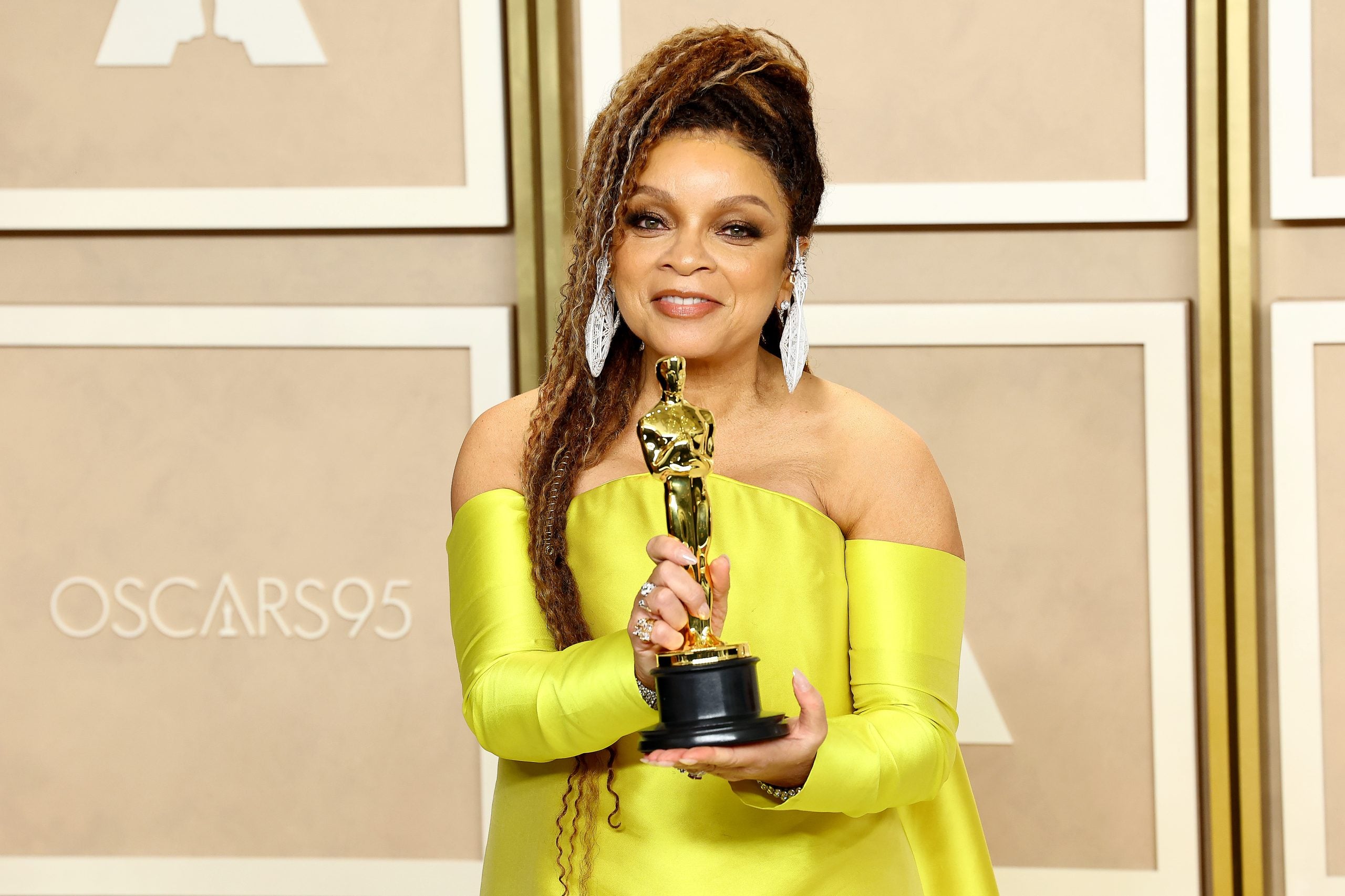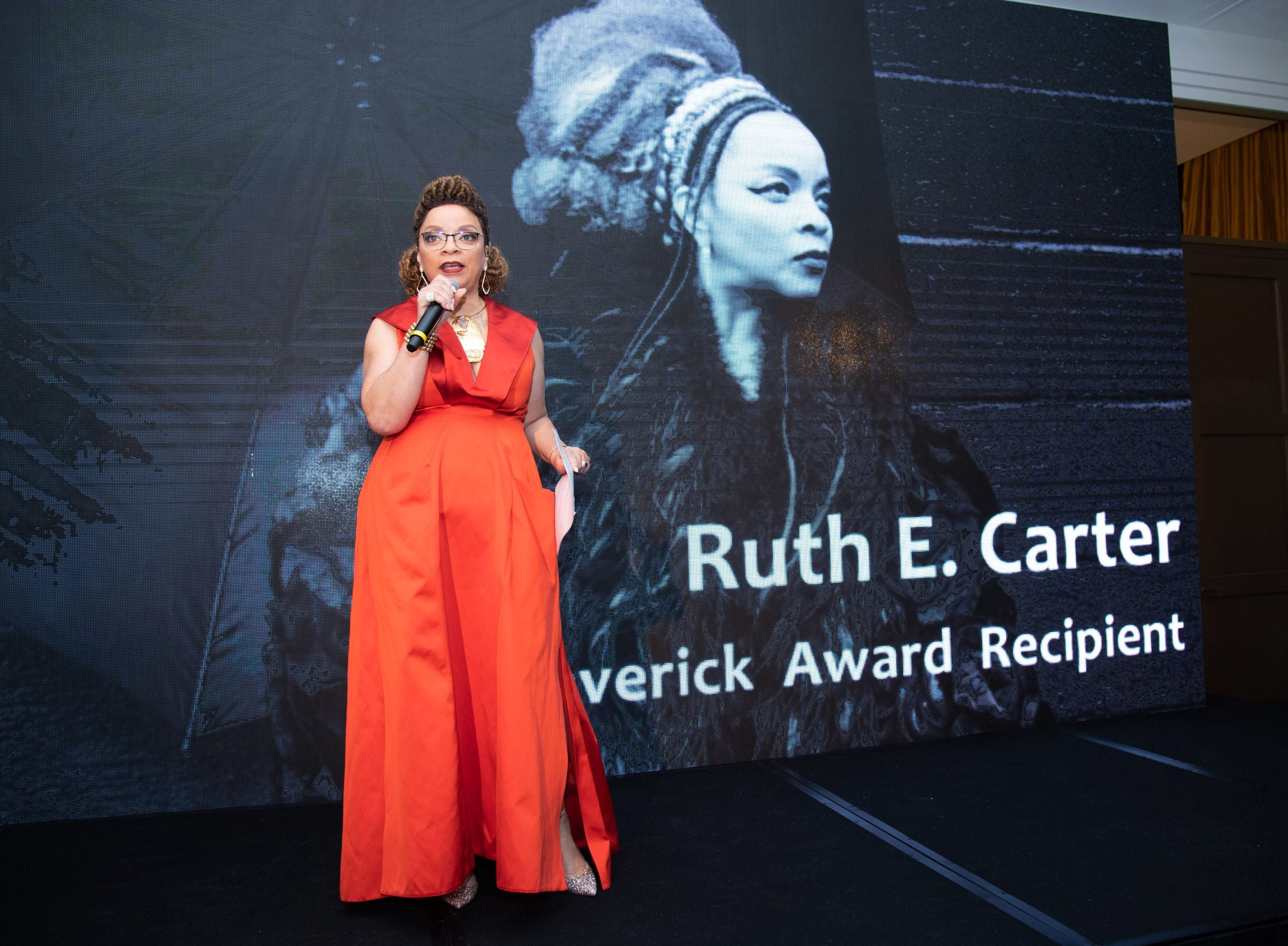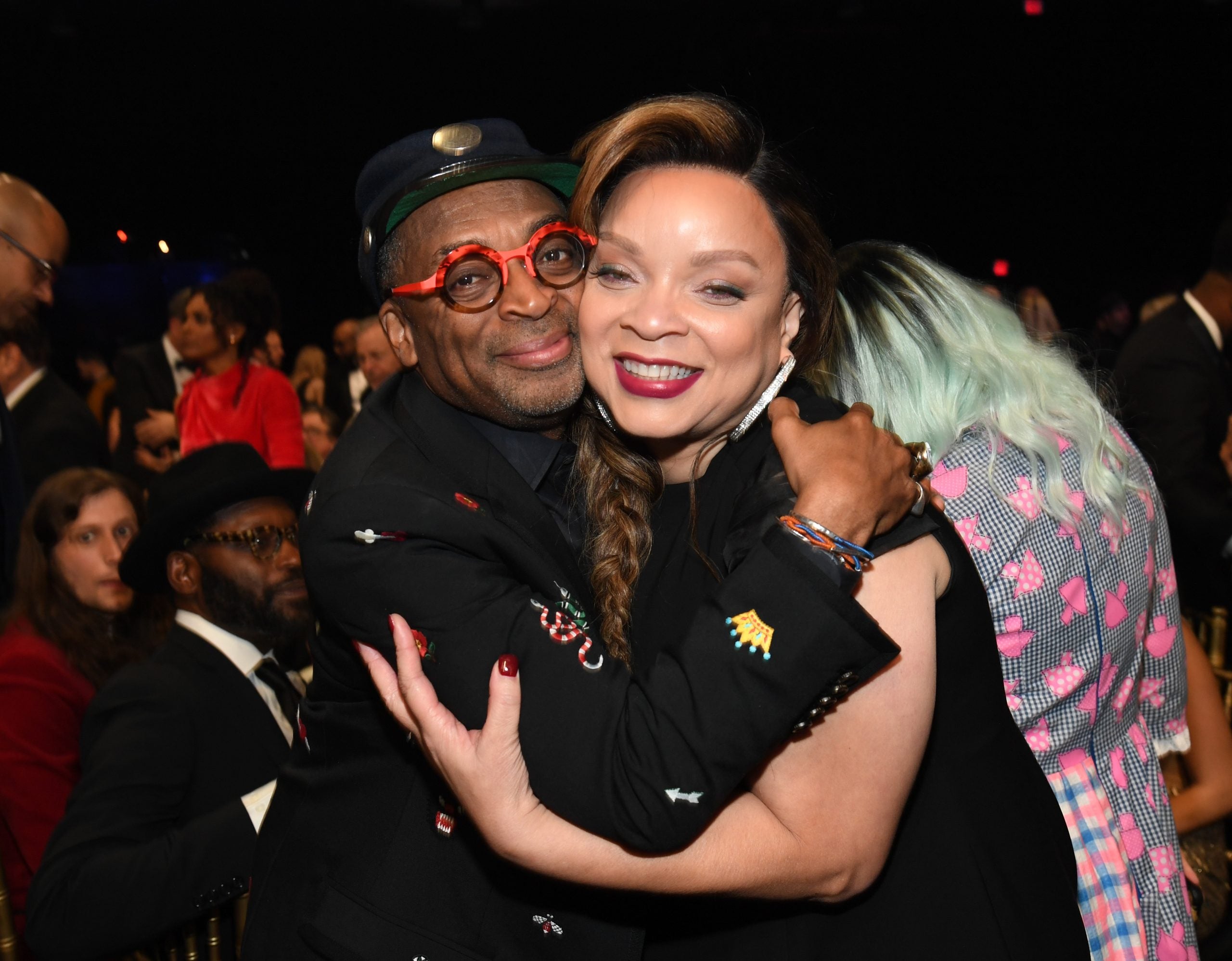
Ruth E. Carter has never sought the approval of white Hollywood. Carter, a lauded costume designer, and the sole Black woman to have won an Academy Award for Best Costume Design, has thrived due to her grit and fixation on telling Black stories through compelling and striking clothing. If you grew up in a Spike Lee-obsessed household like me, you may have heard of Carter before. Alternatively, you might have discovered the politically charged and family-centric films of the director, screenwriter, and Oscar winner as an adult. As a budding costume designer and image architect, Carter collaborated with Lee on his feature films, including School Daze, Do The Right Thing, Jungle Fever, Malcolm X, and many more, for over 24 years.
During our conversation, what struck me most was how enthusiastic Carter still is about filmmaking and the effort required to create historically significant moments on movie sets. Garments are a large part of this process, and she revels in being a part of a creative process–she’s well aware of how poignant her role is in the process of movie-making. This is why it’s so significant when she expresses how her time at Hampton University, a historically Black college, was filled with pivotal moments. Her time there was a cohesive and colorful journey that allowed her space to dream and cut her teeth in the theater department. She found herself creating costumes for organizations and also a dance troupe on campus. While there Carter tells me she was supported not just by her peers, but also by her professors.
After completing various internships and relocating to Los Angeles, she crossed paths with Spike Lee. This encounter led to a valuable learning experience as a costume designer on set. Shortly thereafter, she landed her first film School Daze which explored the dynamics of college life with its colorful and dynamic visuals. This was a perfect fit for her, as a graduate of an HBCU, she felt that she was able to bring authenticity and a lived-in feel to the project.
Carter’s career is truly iconic and in many ways, she serves as a blueprint for many designers who have followed in her footsteps. Her dedication to creating delightful and at times, enchanting clothing is undeniable, and her work adds to the characterization and plotlines of films. It’s much more than just an eye for fashion; she sets a high standard that pushes forward the storytelling within each movie she works on. In the confines of Hollywood, where trends and faces come and go, she is a rarity, a gem, and an overall expert in her craft. With years of experience, she has paved her own path to success through Black films, and to witness her work is to observe masterpieces in real-time.
Below, we spoke with the Oscar-winning costume designer Ruth E. Carter on her journey to success, meeting and working with her creative collaborator, the director and screenwriter Spike Lee, and what keeps her going.

What was your first notion that creative expression through clothing was pivotal to who you are?
As a kid, I didn’t know that I was going to be a costume designer. I had siblings, my brothers were artists so I was drawing as a kid. I was playing around with a sewing machine as a kid. I was in summer programs that were drama programs, I was in Black enrichment programs, [and] Kwanzaa celebrations. So I think the road to becoming a costume designer for me started when I was a child not realizing that all of those things were what a costume designer does.
What were some of the activities that you were involved in as a child?
I was in the Uhuru Sasa program at Amherst College, I was in Upward Bound at UMass Amherst, [and] I was at Camp Atwater, which was an all-Black camp in East Brookfield, Massachusetts. Every summer there was a program [created] to enrich the minds of young inner-city Black children. Because I was in Massachusetts a lot of those programs were led by very conscious Black students.
How old were you when you first used a sewing machine?
Nine. It actually wasn’t a Singer. The brand was White, a company that built sewing machines in Massachusetts—the White Sewing Machine Company. So I can only think that my mother got that old sewing machine, and she put it in my room when I was nine years old. When I was nine, it looked like a desk, and I was drawing on it.
Then I discovered when I opened the leaflet on this white machine you pulled out a sewing machine, and so this became a whole situation, a whole desk-like sewing room kind of a thing. It even had a smaller leaflet on the other side that opened. So you had a long table with a sewing machine on top. So, for a nine-year-old who is often playing in her room, I opened up the drawers and found patterns and learned [from] the instructions you have to go to the codes and all that kind of stuff, and so I figured out what everything meant.
And I started sewing on there, but no I wasn’t like: “I’m gonna make a tailor jacket. Wow! I’m gonna make myself a first day of school dress.” I was just sewing some stuff together.
I was opening up my jeans and making a skirt. I was inventing and reinventing. My mom was a single parent, [so] I had to go upstairs in the attic and find the clothes no one wanted and make something else. They call that repurposing now. I didn’t wear anything that I made, I just liked making [things].

While at HBCUs we’re often in community with those who are like us or polar opposites. Were you in creative community while at Hampton University with your peers?
Yes. That was our experience, all of us in the theater department. We had T-shirts that said, “We won’t stop until we’re a star.” And today you know Robbie Reed is a famous casting director for BET, she was in my dorm. Ray Dowell works at BET [as the senior manager of unscripted content]. We were all trying to be actors. That was the part. I branched off and started designing the costumes, and so I was involved with everything. Whereas they might have been in the play, one play or another, I was doing everything, so I spent all of my time in the theater and hardly did the class. But we did have that spirit, and our theater instructors really believed in us. We were a troop of maybe six of us who kind of banded together. But the whole theater department was a creative space.
Would you say your time there prepared you for your career?
Well, I did so many things like I was the costume designer for the dance troupe the [Terpsichorean Dance Company] at Hampton, and they traveled, and but I stayed on campus [during] the Christmas holiday when nobody else was on [campus]. Everybody was home with their family, having a Christmas holiday. I actually was off campus. I had access to campus. We [were] very close, but I was in an apartment so I could pretend that I was having a Christmas meal or whatever. But I was really sewing up a bunch of costumes. I was involved with everything. I [worked with] Alpha Phi Alpha there they reenacted Michael Jackson’s “Thriller,” and I did all the costumes single-handedly. This is me doing stuff like for dozens of people by myself.
So I was kind of like a loner, in a way. When you do stuff like that on your own. You can’t help but mentally get into the space of I’m going to be a costume designer. That’s why I’m sacrificing this holiday. I’m going to be a costume designer. That’s why I [didn’t] mind working this hard for something that I truly wanted to be my career.
Did your move to Los Angeles in 1986 feel like a rebirth?
There was an in-between. When I first packed up. I did internships. I did one in New Mexico at the opera. So when my brother’s in-laws heard that I was pursuing a career as a costume designer, they offered me housing in their home because they were empty nesters, and they said I could live with them for a year in Los Angeles if I wanted to pursue costume design for feature films.
But I was a theater person, not a feature film person. So I said, yes, not realizing that there’s not a lot of fear going on in LA and so when I drove from New Mexico to LA in my Volkswagen Rabbit. I was aspiring. I didn’t aspire to be huge, I aspired to get a job in a costume department because I had a skillset. I knew it wasn’t going to be easy to get a job as a costume designer, but I knew I could get a job in a costume department. I was taking my skillset across cross country.
I was trying to be in the craft of costume design, I knew that I had a craft that I enjoyed. I enjoyed painting on fabric so I got a job as a fabric painter at Western Costume. I enjoyed sewing and aging [clothes] so I had designers dropping off clothes to my apartment to dye down and make them look old. I actually enjoyed the craft. As much as I was still pursuing this end result of being a costume designer in between, I was working.
Eventually, you met Spike Lee, and this ensued in your 24-plus-year partnership as a director and costume designer. Can you tell me about the origins of this?
Yeah, I was in Los Angeles. I was working downtown for a theater company and a dance performance came through, and they needed a costume designer. So I volunteered and the show became super popular. It was out of South Central LA. They were performing A Night For Dancing. That’s what it was called, and it was to Stevie Wonder’s Songs [in] the Key of Life. And people loved it, and it was being performed in a little dance studio, the Lula Washington [Dance Theatre] which is in South Central LA.
And Spike came to see the show, he was with my friend Robbie Reid, who is the casting director at BET and she introduced us, but he wasn’t a famous person. He was unknown [we all were] He’s 3 years older than me. So then we were all in the same age range. Afterward, we went to a club in LA. [Next] he was talking to me about getting film experience. He was telling me what to do and he was serious. This was a filmmaker pursuing, pursuing a costume design and I took his advice.
Did you take a few courses after connecting with Spike Lee?
No. [Since I’d] already graduated from college [and] I’m working in the Los Angeles area he said, go to USC Or UCLA to the film studies department and sign up to work on a film student’s senior thesis project. And he said, “You’ll be on a set just like on a big movie. They’ll have all the same equipment. They’ll have all the same roles that any Hollywood movie would have and that way you’ll get some film experience.”
So I did. I went to USC. And before I knew it on the weekends. I was hearing “quiet on the set” and “rolling” for the first time. I thought, “Wow, this is really subtle, like I can’t even hear what the actors are saying from where I was standing. But this is like another medium.” And I thought: How can I teach myself how to translate costumes into this medium shortly after that Spike Lee called me up and asked me to do [costume design for my first film] School Daze.

Was working on School Daze a phenomenal lived-in experience for you?
Phenomenal lived-in experience, yes, that I went to [an] HBCU myself so [it felt] lived in, in that way. Phenomenal in that my first movie is a movie that I can completely relate to as being from an HBCU myself. And working with my fellow HBCU comrades, Spike went to Morehouse, Robbie went to Hampton, and lived right across the hall from me in the same dorm. And yet, here we are all together as filmmakers.
And so it was very easy for me because I did the Alpha Phi Alpha step shows. I did all kinds of stuff. So when it came to dressing sororities I saw all that pledging. It was right there in your face, you know. Pledging was very visual. So, for me to do the Gamma Rays, the fellows, and the Gamites, I could relate to it. I didn’t want to say it was easy but I didn’t have to do a whole lot of research, I could just dive right in.
How was it receiving your first Oscar nomination for Malcolm X?
I did not feel like I needed Hollywood, and, as a matter of fact, as Black filmmakers, we were proud to be independent of Hollywood. I was making good money. I had an apartment in New York, and I had an apartment in LA. They were small but I was bicoastal, and I was active. I did 2.5 movies every year. I do two movies and one would bleed into the next. So I was busy, and I didn’t have time to think about what Hollywood was doing, because, actually, you know, working for Spike, you had such training in film, and what films were good films, and what films weren’t good films, and most of the films that we felt were not good ones were the ones that Hollywood was producing at that time.
Can you tell me what has been one of your proudest moments, if not being the first Black woman to win an Academy Award for Best Costume Design for Black Panther in 2018?
When you’re able to accomplish a really big accomplishment like Malcolm X, right? Malcolm X was just me. And I hired a couple of my design assistants and we did it all ourselves like there was not a Hollywood system in place. I gathered the clothes. I went to the costume houses, and I pulled the clothes myself, and we set up at 40 Acres and a Mule Spike’s Company. We were in a garage that had 4 levels, and every level was a different era in Malcolm X’s life. So the first floor was the 1920s, [and] all the clothes from the 1920s, and it went thirties, forties, fifties, and sixties was at the top floor. We were making that movie by any means necessary. We shot all over New York City [and in] Egypt. I did that whole movie with my brainpower. I was fully in charge and I am fully in charge of all of my movies. But that one in particular was my first really big movie.
As the years progress, what keeps you going?
I step outside myself, and I’m always a part of what I see as growth for my profession and my professional knowledge. When I say that I mean I’ve been a person who did not worry about fitting in. I didn’t worry about having everything myself personally. I didn’t worry about trends. So, what keeps me going is my ability to immerse myself in what I feel is important, and that is culture, understanding people better, [and] being an advocate for social justice.







